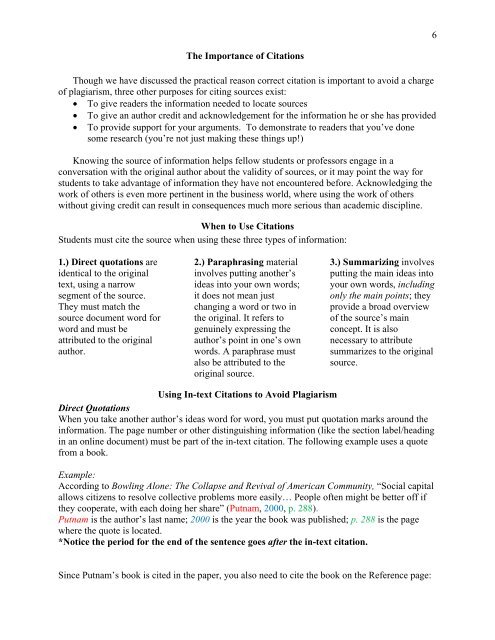What is plagiarism, and why is it important at Franklin ... - My Franklin
What is plagiarism, and why is it important at Franklin ... - My Franklin
What is plagiarism, and why is it important at Franklin ... - My Franklin
- No tags were found...
You also want an ePaper? Increase the reach of your titles
YUMPU automatically turns print PDFs into web optimized ePapers that Google loves.
6<br />
The Importance of C<strong>it</strong><strong>at</strong>ions<br />
Though we have d<strong>is</strong>cussed the practical reason correct c<strong>it</strong><strong>at</strong>ion <strong>is</strong> <strong>important</strong> to avoid a charge<br />
of plagiar<strong>is</strong>m, three other purposes for c<strong>it</strong>ing sources ex<strong>is</strong>t:<br />
• To give readers the inform<strong>at</strong>ion needed to loc<strong>at</strong>e sources<br />
• To give an author cred<strong>it</strong> <strong>and</strong> acknowledgement for the inform<strong>at</strong>ion he or she has provided<br />
• To provide support for your arguments. To demonstr<strong>at</strong>e to readers th<strong>at</strong> you’ve done<br />
some research (you’re not just making these things up!)<br />
Knowing the source of inform<strong>at</strong>ion helps fellow students or professors engage in a<br />
convers<strong>at</strong>ion w<strong>it</strong>h the original author about the valid<strong>it</strong>y of sources, or <strong>it</strong> may point the way for<br />
students to take advantage of inform<strong>at</strong>ion they have not encountered before. Acknowledging the<br />
work of others <strong>is</strong> even more pertinent in the business world, where using the work of others<br />
w<strong>it</strong>hout giving cred<strong>it</strong> can result in consequences much more serious than academic d<strong>is</strong>cipline.<br />
When to Use C<strong>it</strong><strong>at</strong>ions<br />
Students must c<strong>it</strong>e the source when using these three types of inform<strong>at</strong>ion:<br />
1.) Direct quot<strong>at</strong>ions are<br />
identical to the original<br />
text, using a narrow<br />
segment of the source.<br />
They must m<strong>at</strong>ch the<br />
source document word for<br />
word <strong>and</strong> must be<br />
<strong>at</strong>tributed to the original<br />
author.<br />
2.) Paraphrasing m<strong>at</strong>erial<br />
involves putting another’s<br />
ideas into your own words;<br />
<strong>it</strong> does not mean just<br />
changing a word or two in<br />
the original. It refers to<br />
genuinely expressing the<br />
author’s point in one’s own<br />
words. A paraphrase must<br />
also be <strong>at</strong>tributed to the<br />
original source.<br />
3.) Summarizing involves<br />
putting the main ideas into<br />
your own words, including<br />
only the main points; they<br />
provide a broad overview<br />
of the source’s main<br />
concept. It <strong>is</strong> also<br />
necessary to <strong>at</strong>tribute<br />
summarizes to the original<br />
source.<br />
Using In-text C<strong>it</strong><strong>at</strong>ions to Avoid Plagiar<strong>is</strong>m<br />
Direct Quot<strong>at</strong>ions<br />
When you take another author’s ideas word for word, you must put quot<strong>at</strong>ion marks around the<br />
inform<strong>at</strong>ion. The page number or other d<strong>is</strong>tingu<strong>is</strong>hing inform<strong>at</strong>ion (like the section label/heading<br />
in an online document) must be part of the in-text c<strong>it</strong><strong>at</strong>ion. The following example uses a quote<br />
from a book.<br />
Example:<br />
According to Bowling Alone: The Collapse <strong>and</strong> Revival of American Commun<strong>it</strong>y, “Social cap<strong>it</strong>al<br />
allows c<strong>it</strong>izens to resolve collective problems more easily… People often might be better off if<br />
they cooper<strong>at</strong>e, w<strong>it</strong>h each doing her share” (Putnam, 2000, p. 288).<br />
Putnam <strong>is</strong> the author’s last name; 2000 <strong>is</strong> the year the book was publ<strong>is</strong>hed; p. 288 <strong>is</strong> the page<br />
where the quote <strong>is</strong> loc<strong>at</strong>ed.<br />
*Notice the period for the end of the sentence goes after the in-text c<strong>it</strong><strong>at</strong>ion.<br />
Since Putnam’s book <strong>is</strong> c<strong>it</strong>ed in the paper, you also need to c<strong>it</strong>e the book on the Reference page:


